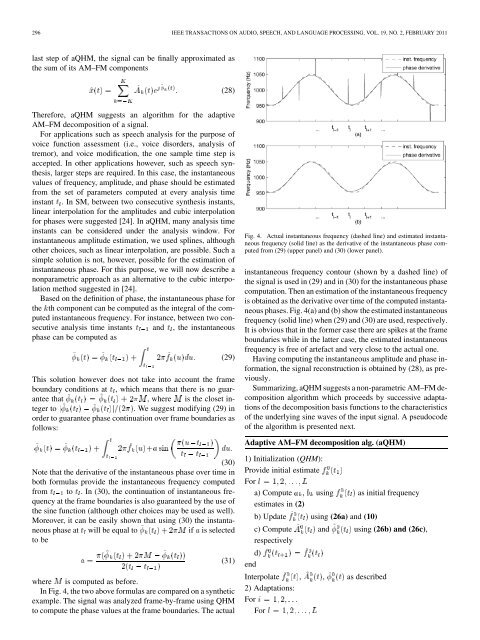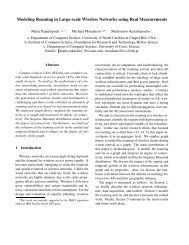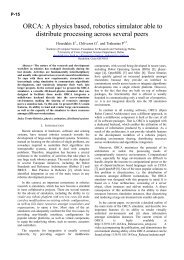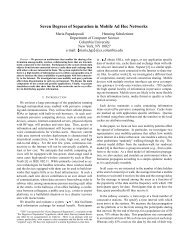Adaptive AM–FM Signal Decomposition With Application to ... - ICS
Adaptive AM–FM Signal Decomposition With Application to ... - ICS
Adaptive AM–FM Signal Decomposition With Application to ... - ICS
Create successful ePaper yourself
Turn your PDF publications into a flip-book with our unique Google optimized e-Paper software.
296 IEEE TRANSACTIONS ON AUDIO, SPEECH, AND LANGUAGE PROCESSING, VOL. 19, NO. 2, FEBRUARY 2011<br />
last step of aQHM, the signal can be finally approximated as<br />
the sum of its <strong>AM–FM</strong> components<br />
(28)<br />
Therefore, aQHM suggests an algorithm for the adaptive<br />
<strong>AM–FM</strong> decomposition of a signal.<br />
For applications such as speech analysis for the purpose of<br />
voice function assessment (i.e., voice disorders, analysis of<br />
tremor), and voice modification, the one sample time step is<br />
accepted. In other applications however, such as speech synthesis,<br />
larger steps are required. In this case, the instantaneous<br />
values of frequency, amplitude, and phase should be estimated<br />
from the set of parameters computed at every analysis time<br />
instant . In SM, between two consecutive synthesis instants,<br />
linear interpolation for the amplitudes and cubic interpolation<br />
for phases were suggested [24]. In aQHM, many analysis time<br />
instants can be considered under the analysis window. For<br />
instantaneous amplitude estimation, we used splines, although<br />
other choices, such as linear interpolation, are possible. Such a<br />
simple solution is not, however, possible for the estimation of<br />
instantaneous phase. For this purpose, we will now describe a<br />
nonparametric approach as an alternative <strong>to</strong> the cubic interpolation<br />
method suggested in [24].<br />
Based on the definition of phase, the instantaneous phase for<br />
the th component can be computed as the integral of the computed<br />
instantaneous frequency. For instance, between two consecutive<br />
analysis time instants and , the instantaneous<br />
phase can be computed as<br />
(29)<br />
This solution however does not take in<strong>to</strong> account the frame<br />
boundary conditions at , which means that there is no guarantee<br />
that , where is the closet integer<br />
<strong>to</strong><br />
. We suggest modifying (29) in<br />
order <strong>to</strong> guarantee phase continuation over frame boundaries as<br />
follows:<br />
(30)<br />
Note that the derivative of the instantaneous phase over time in<br />
both formulas provide the instantaneous frequency computed<br />
from <strong>to</strong> . In (30), the continuation of instantaneous frequency<br />
at the frame boundaries is also guaranteed by the use of<br />
the sine function (although other choices may be used as well).<br />
Moreover, it can be easily shown that using (30) the instantaneous<br />
phase at will be equal <strong>to</strong> if is selected<br />
<strong>to</strong> be<br />
(31)<br />
where is computed as before.<br />
In Fig. 4, the two above formulas are compared on a synthetic<br />
example. The signal was analyzed frame-by-frame using QHM<br />
<strong>to</strong> compute the phase values at the frame boundaries. The actual<br />
Fig. 4. Actual instantaneous frequency (dashed line) and estimated instantaneous<br />
frequency (solid line) as the derivative of the instantaneous phase computed<br />
from (29) (upper panel) and (30) (lower panel).<br />
instantaneous frequency con<strong>to</strong>ur (shown by a dashed line) of<br />
the signal is used in (29) and in (30) for the instantaneous phase<br />
computation. Then an estimation of the instantaneous frequency<br />
is obtained as the derivative over time of the computed instantaneous<br />
phases. Fig. 4(a) and (b) show the estimated instantaneous<br />
frequency (solid line) when (29) and (30) are used, respectively.<br />
It is obvious that in the former case there are spikes at the frame<br />
boundaries while in the latter case, the estimated instantaneous<br />
frequency is free of artefact and very close <strong>to</strong> the actual one.<br />
Having computing the instantaneous amplitude and phase information,<br />
the signal reconstruction is obtained by (28), as previously.<br />
Summarizing, aQHM suggests a non-parametric <strong>AM–FM</strong> decomposition<br />
algorithm which proceeds by successive adaptations<br />
of the decomposition basis functions <strong>to</strong> the characteristics<br />
of the underlying sine waves of the input signal. A pseudocode<br />
of the algorithm is presented next.<br />
<strong>Adaptive</strong> <strong>AM–FM</strong> decomposition alg. (aQHM)<br />
1) Initialization (QHM):<br />
Provide initial estimate<br />
For<br />
a) Compute , using as initial frequency<br />
estimates in (2)<br />
b) Update using (26a) and (10)<br />
c) Compute and using (26b) and (26c),<br />
respectively<br />
d)<br />
end<br />
Interpolate , , as described<br />
2) Adaptations:<br />
For<br />
For
















